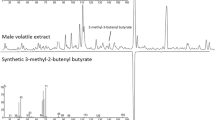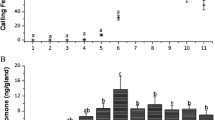Abstract
In a four-armed airflow olfactometerTrichogramma evanescens Westwood females were attracted by a volatile substance(s) released by virgin females of the great cabbage white butterfly,Pieris brassicae L. Males or recently mated females did not cause attraction. Furthermore,T. evanescens was also attracted by volatiles released by calling virgin cabbage moths,Mamestra brassicae L. However, the parasites did not respond to (Z)-11-hex-adecenylacetate (the main component of the sex pheromone ofM. brassicae), a crude hexane extract of the sex pheromone gland, or to males or recently mated females.
Similar content being viewed by others
References
Altieri, M.A., Lewis, W.J., Nordlund, D.A., Gueldner, R.C., andTodd, J.W. 1981. Chemical interactions between plants andTrichogramma wasps in Georgia soybeam fields.Prot. Ecol. 3:259–263.
Bar, D., Gerling, D., andRossler, Y. 1979. Bionomics of the principal natural enemies attackingHeliothis armigera in cotton fields in Israel.Environ. Entomol. 8:468–474.
Bergström, G., andLundgren, L. 1973. Androconial secretion of three species of butterflies of the genusPieris (Lep., Pieridae).Zoon, Suppl. 1:67–75.
Bestmann, H.J., Vostrowsky, O., Koschatsky, K.H., Platz, H., Szymanska, A., andKnauf, W. 1978. Pheromone XVII. (Z)-11-Hexadecenylacetat, ein Sexuallockstoff des Pheromonsystems der KohleuleMamestm brassicae.Tetrahedron Lett. 6:605–608.
Brown, W.L., Jr, Eisner, T., andWhittaker, R.H. 1970. Allomones and kairomones: transspecific chemical messengers.BioScience 20:21–22.
Byrne, K.J., Gore, W.F., Pearce, G.T., andSilverstein, R.M. 1975. Porapak-Q collection of airborne organic compounds serving as models for insect pheromones.J. Chem. Ecol. 1:1–7.
Chovet, G. 1982. Le comportement sexuel dePieris brassicae L. (Lép. Pieridae).Ann. Soc. Entomol. Fr. 18:461–474.
David, W.A.L., andGardiner, B.O.C. 1961. The mating behavior ofPieris brassicae in a laboratory culture.Bull. Entomol. Res. 52:263–280.
Farine, J.P., Frêrot, B., andIsart, J. 1981. Facteurs d'isolement chimique dans la sécrétion phéromonale de deux Noctuelles Hadeninae:Mamestm brassicae (L.) etPseudaletia unipuncta (Haw.).C.R. Acad. Sci. Paris Série D 292:101–104.
Farkas, S.R., andShorey, H.H. 1974. Mechanisms of orientation to a distant pheromone source, pp. 81–95,in M.C. Birch, (ed.). Pheromones. American Elsevier, New York.
Feltwell, J. 1982. The Large White Butterfly: Biology, BioChemistry and Physiology ofPieris brassicae (Linnaeus). Junk, The Hague. 524 pp.
Greenblatt, J.A., andLewis, W.J. 1983. Chemical environment manipulation for pest insects control.Environ. Manag. 7:35–41.
Gross, H.R., Jr., Lewis, W.J., andNordlund, D.A. 1981.Trichogramma pretiosum: Effect of prerelease parasitization experience on retention in release areas and efficiency.Environ. Entomol. 10:554–556.
Lenteren, J.C. van, Glas, P.C.G., andSmits, P.H. 1982. Evaluation of control capabilities ofTrichogramma and results of laboratory and field research onTrichogramma in the Netherlands.Les Trichogrammes, Amibes, Les Colloques de l'INRA. 9:257–268.
Lewis, W.J., Nordlund, D.A., Gueldner, R.C., Teal, P.E.A., andTumlinson, J.H. 1982. Kairomones and their use for management of entomophagous insects. XIII. Kairomonal activity forTrichogramma spp. of abdominal tips, excretion, and a synthetic sex pheromone blend ofHeliothis zea (Boddie) moths.J. Chem. Ecol. 8:1323–1331.
Myers, J. 1972. Pheromones and courtship behavior in butterflies.Am. Zool. 12:545–551.
Noldus, L.P.J.J., andLenteren, J.C. van 1985. Kairomones for the egg parasiteTrichogramma evanescens Westwood. II. Effect of contact chemicals produced by two of its hosts,Pieris brassicae L. andPieris rapae L.J. Chem. Ecol. 11:793–800.
Nordlund, D.A., andLewis, W.J. 1976. Terminology of chemical releasing stimuli in intraspecific and interspecific interactions.J. Chem. Ecol. 2:211–220.
Nordlund, D.A., Lewis, W.J., andGueldner, R.C. 1983. Kairomones and their use for management of entomophagous insects. XIV. Response ofTelenomus remus to abdominal tips ofSpodoptera frugiperda as well as to (Z)-9-tetradece-1-ol acetate and (Z)-9-dodece-1-ol acetate.J. Chem. Ecol. 9:695–701.
Novak, L., Tóth, M., Balla, J., andSzantay, C. 1979. Sex pheromone of the cabbage armyworm,Mamestra brassicae: Isolation, identification and stereocontrolled synthesis.Acta Chim. Acad. Sci. Hung. 102:135–140.
Pope, M.M., Gaston, L.K., andBaker, T.C. 1982. Composition, quantification and periodicity of sex pheromone gland volatiles from individualHeliothis virescens females.J. Chem. Ecol. 8:1043–1055.
Schaaf, D.A. van der, Kaskens, J.W.M., Kole, M., Noldus, L.P.J.J., Lenteren, J.C. van, andPak, G.A., 1984. Experimental releases of two differentTrichogramma spp. strains against lepidopteran pests in a brussels sprouts field crop in the Netherlands.Med. Fac. Landbouww. Rijksuniv. Gent. 49:803–813.
Scott, J.A. 1974. Mate-locating behavior of butterflies.Am. Midl. Nat. 91:103–117.
Smits, P.H. 1982. The influence of kairomones ofMamestra brassicae on the searching behaviour ofTrichogramma evanescens.Les Trichogrammes, Antibes, Les Colloques de l'INRA 9:139–150.
Struble, D.L., Arn, H., Buser, H.R., Stadler, E., andFreuler J. 1980. Identification of four sex pheromone components isolated from calling females ofMamestra brassicae.Z. Naturforsch. 35c:45–48.
Szentesi, A., Tóth., M., andDobrovolsky, A. 1975. Evidence and preliminary investigations on a male aphrodisiac and a female sex pheromone inMamestra brassicae (L.)Acta Phytopathol. Acad. Sci. Hung. 10:425–429.
Terytze, K., andAdam, H. 1981. Zur Verwendung von Pheromonfallen für die biologische Bekämpfung der Kohleule (Barathra brassicae L.) mittels Eiparasiten der GattungTrichogramma (T. evanescens Westwood).Arch Phytopathol. Pflanzenschutz. 17:387–396.
Tumlinson, J.H.,Heath, R.R., andTeal, P.E.A. 1982. Analysis of chemical communication systems of Lepidoptera, pp. 1–25,in B. Leonhardt and M. Beroza (eds.). Insect Pheromone Technology: Chemistry and Applications. A.C.S. Symposium Series 190, Washington, D.C.
Vet, L.E.M., Lenteren, J.C. van, Heymans, M., andMeelis, E. 1983. An airflow olfactometer for measuring olfactory responses of hymenopterous parasitoids and other small insects.Physiol. Entomol. 8:97–106.
Vinson, S.B. 1981. Habitat location, pp. 51–77,in D.A. Nordlund, R.L. Jones, and W.J. Lewis (eds.). Semiochemicals, Their Role in Pest Control. John Wiley, New York.
Weseloh, R.M. 1981. Host location by parasitoids, pp. 79–95,in D.A. Nordlund, R.L. Jones, and W.J. Lewis (eds.). Semiochemicals, Their Role in Pest Control. John Wiley, New York.
Author information
Authors and Affiliations
Additional information
Hymenoptera: Trichogrammatidae.
Lepidoptera: Pieridae.
Lepidoptera: Noctuidae.
Rights and permissions
About this article
Cite this article
Noldus, L.P.J.J., van Lenteren, J.C. Kairomones for the egg parasiteTrichogramma evanescens Westwood. J Chem Ecol 11, 781–791 (1985). https://doi.org/10.1007/BF00988305
Received:
Accepted:
Issue Date:
DOI: https://doi.org/10.1007/BF00988305




